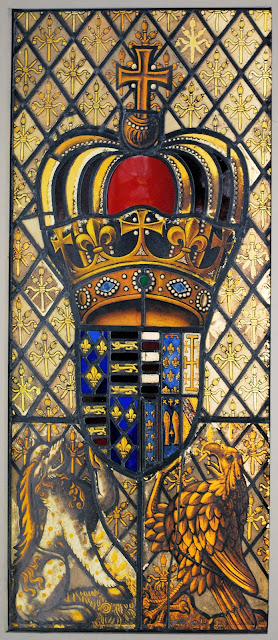... is it, in fact, heraldry?
Well, not necessarily.
One of the things that you see if you look up immediately after entering Ely Cathedral is this complex painted and decorated ceiling.
Perhaps the first thing you notice (if you are not a heraldry enthusiast like myself), are the complex crosses and Chi-Rhos* in the blue panels.
But then, among the red panels, some of which are decorated with intricate vegetable knotwork, are angels holding shields that would be blazoned Or a cross bottony gules.
But then, among the red panels, some of which are decorated with intricate vegetable knotwork, are angels holding shields that would be blazoned Or a cross bottony gules.
But are these shields really heraldic? They could be Gullat/Gullet (Or a cross bottony gules), but the general consensus is that they are more likely for general Christian iconography than they are truly heraldic.
So, probably not "real" heraldry, but certainly "heraldry-adjacent".
And leaving me, at least, with the question of how much it might cost to do something like this in my living room ceiling at home. (The short answer: Probably more than I can reasonably afford.)
* The Chi Rho is one of the earliest forms of a Christogram, formed by superimposing the first two letters—chi and rho —of the Greek word ΧΡΙΣΤΟΣ [Christos, or Christ] in such a way that the vertical stroke of the rho intersects the center of the chi. (The Greek for Christ is also the source of the abbreviation "Xmas" for "Christmas", but many do not remember the origin of the abbreviation Xmas here.)
* The Chi Rho is one of the earliest forms of a Christogram, formed by superimposing the first two letters—chi and rho —of the Greek word ΧΡΙΣΤΟΣ [Christos, or Christ] in such a way that the vertical stroke of the rho intersects the center of the chi. (The Greek for Christ is also the source of the abbreviation "Xmas" for "Christmas", but many do not remember the origin of the abbreviation Xmas here.)



















